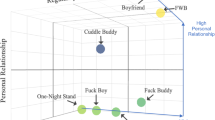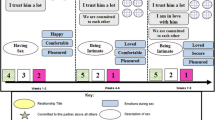Abstract
Delaying sexual intercourse after initiating a relationship (i.e., increasing the presexual period) and delaying unprotected sex can reduce HIV/STI risk. Past relationship and risk experiences may influence sexual decisions in a current relationship. We examined how past relationship and risk experiences of both members of 296 young pregnant couples influenced length of presexual period and time to unprotected sex. Forty-six percent of couples had sex within the first month of seeing each other and had unprotected sex within 1 month of having sex. Length of presexual period and time to unprotected sex were significantly shorter in their current relationship than their previous relationship for both men and women (all p < 0.05). Female past relationship and risk factors were more strongly associated with length of presexual relationship than male past relationship and risk factors. Both male and female past relationship and risk factors were associated with time to unprotected sex.
Similar content being viewed by others
References
Centers for Disease Control and Prevention (CDC). Sexually transmitted disease surveillance 2009. Atlanta: U.S. Department of Health and Human Services; 2010.
CDC. Youth risk behavior surveillance—United States, 2009. Surveillance summaries. Atlanta: Centers for Disease Control and Prevention; 2010.
Scott ME, Wildsmith E, Welti K, Ryan S, Schelar E, Steward-Streng NR. Risky adolescent sexual behaviors and reproductive health in young adulthood. Perspect Sex Reprod Health. 2011;43(2):110–8.
Manlove J, Welti K, Barry M, Peterson K, Schelar E, Wildsmith E. Relationship characteristics and contraceptive use among young adults. Perspect Sex Reprod Health. 2011;43(2):119–28.
Fortenberry JD, Tu W, Harezlak J, Katz BP, Orr DP. Condom use as a function of time in new and established adolescent sexual relationships. Am J Public Health. 2002;92(2):211–3.
Garnett GP, White PJ, Ward H. Fewer partners or more condoms? Modelling the effectiveness of STI prevention interventions. Sex Transm Infect. 2008;84(Suppl 2):ii4–11.
Pinkerton SD, Abramson PR. Evaluating the risks: a bernoulli process model of HIV infection and risk reduction. Eval Rev. 1993;17(5):504–28.
Ku L, Sonenstein FL, Pleck JH. The dynamics of young men’s condom use during and across relationships. Fam Plann Perspect. 1994;26(6):246–51.
Kusunoki Y, Upchurch D. Contraceptive method choice among youth in the United States: the importance of relationship context. Demography. 2011;48(4):1451–72.
Kershaw T, Ethier K, Niccolai L, Lewis J, Milan S, Meade C, et al. Let’s stay together: relationship dissolution and sexually transmitted diseases among parenting and non-parenting adolescents. J Behav Med. 2010;33(6):454–65.
Kershaw T, Arnold A, Gordon D, Magriples U, Niccolai L. In the heart or in the head: relationship and cognitive influences on sexual risk among young couples. AIDS Behav. 2012;16:1522–31.
Manning WD, Flanigan CM, Giordano PC, Longmore MA. Relationship dynamics and consistency of condom use among adolescents. Perspect Sex Reprod Health. 2009;41(3):181–90.
Misovich SJ, Fisher JD, Fisher WA. Close relationships and elevated HIV risk behavior: evidence and possible underlying psychological processes. Rev Gen Psychol. 1997;1(1):72–107.
Forste R, Morgan J. How relationships of U.S. men affect contraceptive use and efforts to prevent sexually transmitted diseases. Fam Plann Perspect. 1998;30(2):56–62.
Furman W, Shaffer L. The role of romantic relationships in adolescent development. In: Florsheim P, editor. Adolescent romantic relations and sexual behavior: theory, research, and practical implications. Mahwah: Lawrence Erlbaum Associates, Inc.; 2003. p. 3–22.
Kershaw TS, Ethier KA, Niccolai LM, Lewis JB, Ickovics JR. Misperceived risk among female adolescents: social and psychological factors associated with sexual risk accuracy. Health Psychol. 2003;22(5):523–32.
Bauman LJ, Berman R. Adolescent relationships and condom use: trust love and commitment. AIDS Behav. 2005;9(2):211–22.
Sbarra DA, Emery RE. The emotional sequelae of nonmarital relationship dissolution: analysis of change and intraindividual variability over time. Pers Relatsh. 2005;12(2):213–32.
Davis D, Shaver PR, Vernon ML. Physical, emotional, and behavioral reactions to breaking up: the roles of gender, age, emotional involvement, and attachment style. Pers Soc Psychol Bull. 2003;29(7):871–84.
Manlove J, Ryan S, Franzetta K. Contraceptive use patterns across teens’ sexual relationships: the role of relationships, partners, and sexual histories. Demography. 2007;44(3):603–21.
Wade LD, DeLamater JD. Relationship dissolution as a life stage transition: effects on sexual attitudes and behaviors. J Marriage Fam. 2002;64(4):898–914.
Moreau C, Beltzer N, Bozon M, Bajos N. Sexual risk-taking following relationship break-ups. Eur J Contracept Reprod Health Care. 2011;16(2):95–9.
Ethier KA, Kershaw T, Niccolai L, Lewis JB, Ickovics JR. Adolescent women underestimate their susceptibility to sexually transmitted infections. Sex Transm Infect. 2003;79(5):408–11.
Matson PA, Adler NE, Millstein SG, Tschann JM, Ellen JM. Developmental changes in condom use among urban adolescent females: influence of partner context. J Adolesc Health. 2011;48(4):386–90.
Kershaw TS, Milan S, Westdahl C, Lewis J, Rising S, Fletcher R, et al. Avoidance, anxiety, and sex: the influence of romantic attachment on HIV-risk among pregnant women. AIDS Behav. 2007;11(2):299–311.
Silverman JG, Raj A, Mucci LA, Hathaway JE. Dating violence against adolescent girls and associated substance use, unhealthy weight control, sexual risk behavior, pregnancy, and suicidality. JAMA. 2001;286(5):572–9.
Rotheram-Borus MJ, Mahler KA, Koopman C, Langabeer K. Sexual abuse history and associated multiple risk behavior in adolescent runaways. Am J Orthopsychiatry. 1996;66(3):390–400.
Harman J, Amico K. The relationship-oriented information-motivation-behavioral skills model: a multilevel structural equation model among dyads. AIDS Behav. 2009;13(2):173–84.
Straus MA, Hamby SL, Boney-McCoy S, Sugarman DB. The revised conflict tactics scales (CTS2). J Fam Issues. 1996;17(3):283–316.
Barry WD, Feldman S. Multiple regression in practice. New York: Sage; 1985.
Wilson SR, Lavori PW, Brown NL, Kao Y-M. Correlates of sexual risk for HIV infection in female members of heterosexual California Latino couples: an application of a Bernoulli process model. AIDS Behav. 2003;7(3):273–90.
Buzi RS, Tortolero SR, Ross MW, Addy RC, Markham CM, Roberts RE. The impact of a history of sexual abuse on high-risk sexual behaviors among females attending alternative schools. Adolescence. 2003;38(152):595–605.
Ickovics et al. High postpartum rates of sexually transmitted infections among teens: pregnancy as a window of opportunity for prevention. Sex Transm Infect 2003;79:469–73.
Meade CS, Ickovics JR. Systematic review of sexual risk among pregnant and mothering teens in the USA: pregnancy as an opportunity for integrated prevention of STD and repeat pregnancy. Soc Sci Med. 2005;60(4):661–78.
Ventura SJ, Mathews TJ, Hamilton BE, Sutton PD, Abma JC. Adolescent pregnancy and childbirth: United States, 1991–2008. In: CDC, editor. Morbidity and mortality weekly report. Atlanta: CDC; 2011.
Centers for Disease Control and Prevention. HIV/AIDS surveillance in adolescents and young adults (through 2007); 2009.
Ott MA, Adler NE, Millstein SG, Tschann JM, Ellen JM. The trade-off between hormonal contraceptives and condoms among adolescents. Perspect Sex Reprod Health. 2002;34(1):6–14.
Acknowledgments
This study is supported by grants from the National Institute of Mental Health (1R01MH075685) and (5P30MH062294).
Author information
Authors and Affiliations
Corresponding author
Rights and permissions
About this article
Cite this article
Kershaw, T., Gerber, R., Divney, A. et al. Bringing Your Baggage to Bed: Associations of Previous Relationship Experiences with Sexual Risk. AIDS Behav 18, 159–170 (2014). https://doi.org/10.1007/s10461-012-0349-0
Published:
Issue Date:
DOI: https://doi.org/10.1007/s10461-012-0349-0




